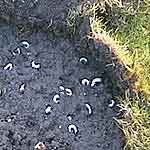

DAMAGE |
Primary damage by grubs of all species is caused by root pruning of grasses, just beneath the growing point. The extensive pruning causes loose turf and water stress. In wet conditions the roots of grasses are able to recover and showing regrowth. As a rule the unwanted grass species take over the empty spaces and become established as strong concurrents of the original grass sward. Normally, a heavily damaged grass sward has to be resown. Secundary damage is caused by larger predators of the grubs, like birds (mainly crows) and mammals like foxes and badgers. The turf becomes loose and tussed.
Grubs of the Garden chafer feed predominantly on grassroots but ornamentals in nearby borders can become endangered (e.g. succulents).
The first instars of Cock chafers start feeding at smaller roots (as well in grass as in trees and shrubs). Later instars take preferably the larger roots and in trees and shrubs the bark of roots below soil level can be damaged. Severe infestation causes the death of the particular plant. In hedgerows the grubs move from one plant to the other, causing dead rows of hedges.
The grubs of the Summer chafer feed exclusively on grass roots. The damage is much similar to the damage of the Garden chafer with which they occur often at the same spot.


Copyright © Insect Consultancy 2002